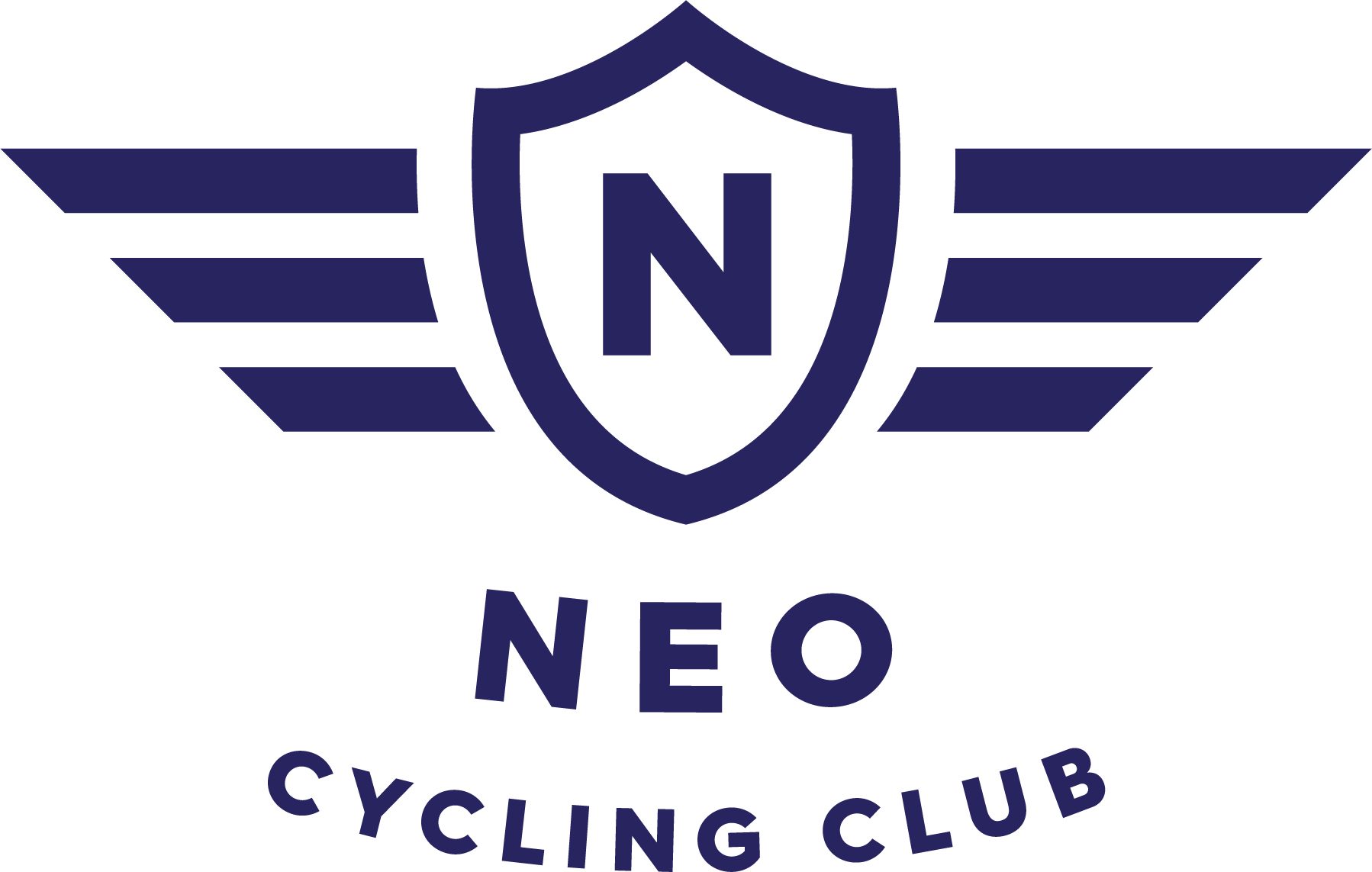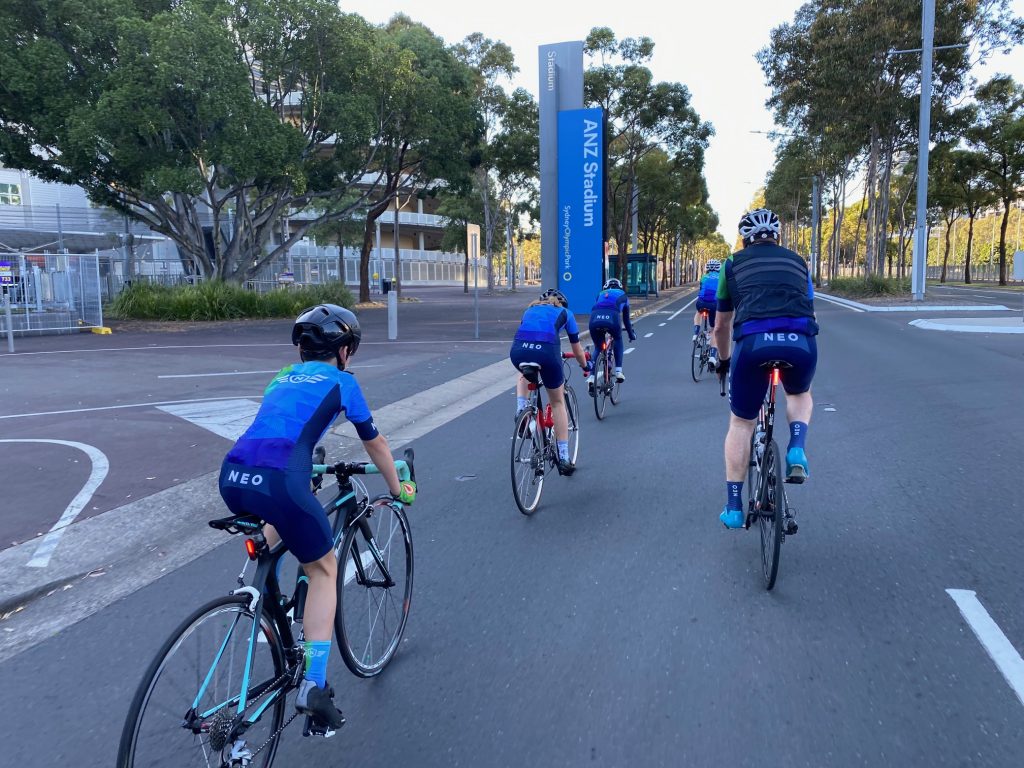Practice makes progress.
We understand that many of our riders have multiple sporting, school and life commitments. We also know many parents work long hours.
That said, making it to club training one or two nights a week will undoubtedly improve your riding skills and performance.
Beginners – Intermediate – Advanced
From October to March we run training on Tuesday & Thursday nights, at Lidcombe Oval, from 5.45pm to 8pm, and strongly encourage all members to attend as many sessions as life permits.
From April to September we run training on Tuesday evening at Dunc Gray Velodrome for the more experienced riders and Wednesday evening at Lidcombe Oval.
Tap one of the options below for more information:
Club Coaching
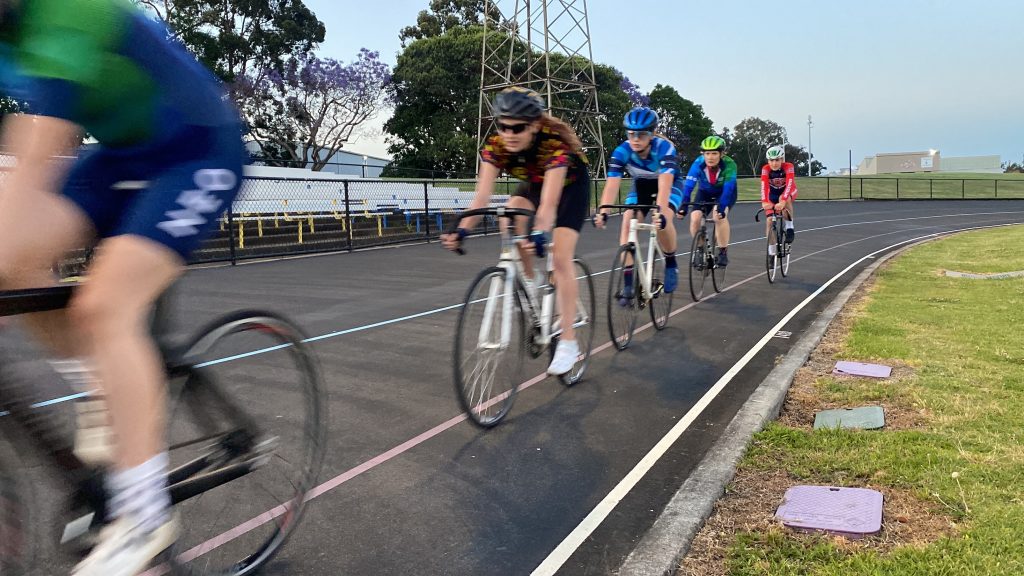
Coaching is run by our highly qualified Head Coach, Dacchi Dang, and focuses on a mix of skill and fitness development, race practice and importantly, having some fun!
Motor-pacing
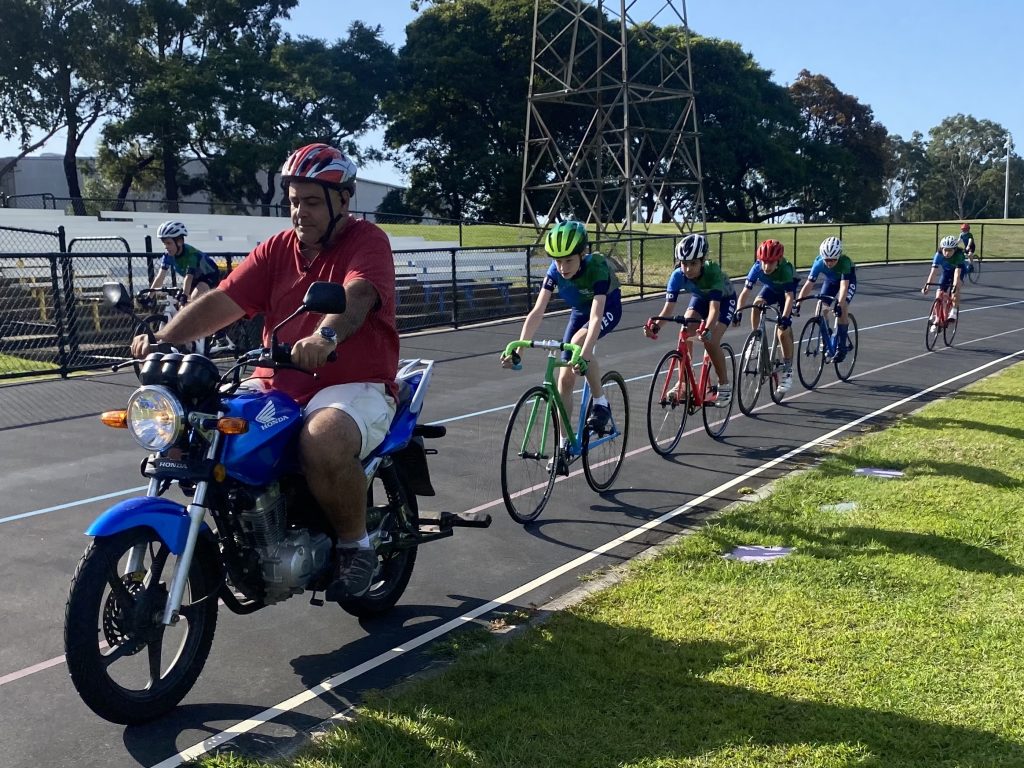
We have the motorbike (or ‘derny’, in cycling speak) out on Tuesday and Thursday nights. The purpose of the derny is to provide motor-pacing to riders, helping them to ride at greater intensity and speed, to improve their leg speed (cadence) by allowing them to over-spin their legs.
Learning to ride confidently in a paceline (a group of riders in single-file), behind the derny is an important skill to develop.
What to bring?
Warm clothing (post-training) and a water bottle.
Lidcombe Oval has its own weather pattern – often cool when the sun goes down, even in the Summer months.
Older juniors and adults are encouraged to bring rollers to warm-up on and use when their training group isn’t on the track.
Communications
If you’re coming to training join our ‘Training’ Facebook Messenger group to get the latest updates on training, weather cancellations etc.
Training groups
We offer three training groups that have varying levels of rider commitment and coaching support, depending on where you are on your cycling journey and where you want to be.
If you’re just starting you can register as a casual and pay-as-you-go at $12 per session, or pay quarterly in advance for a better deal (pre-payment required for Development and Performance groups).
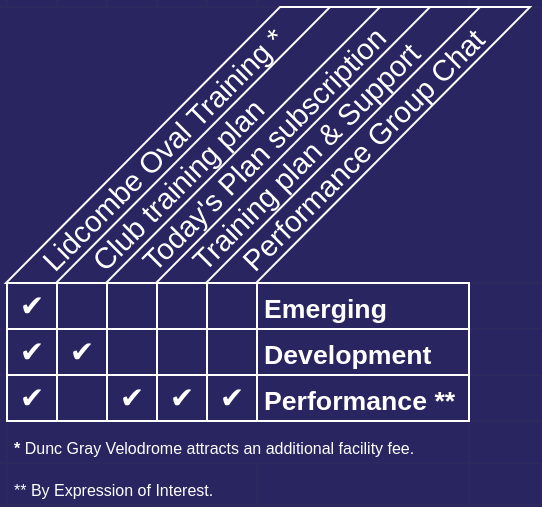
Emerging
The Emerging training group is perfect for riders who are just there to have fun both on and off the bike. They have a chance to learn, develop skills and improve their fitness in a fun environment.
Emerging riders typically attend our regular Tuesday and/or Thursday night training sessions (as often as possible) and our club racing on Sunday afternoons. There’s no expectation of you undertaking additional self-directed training outside of our organised training sessions.
By pre-paying you can access over 20 sessions at a heavily discounted bulk price. -Less than half the cost of a casual visit.
Development
Our Development group is perfect for riders who wish to compete and improve their performance at club racing or State level carnivals and tours.
This group follows a club training program designed to improve performance, with a peak at State Champs towards the end of the season.
Following the club training program involves attending our regular Tuesday / Thursday night sessions, club racing on Sunday afternoons, and other recommended self-directed training activities during the week.
Riders are encouraged to track their training data online through the likes of Strava, Garmin Connect, or Today’s Plan.
Performance
Our Performance group caters for our higher-performance riders, seeking State or National level representation or pathways to elite level. This registration is by ‘expressions of interest’. Talk to one of our coaches to understand the commitment required from a rider and what it takes to be considered.
This registration includes;
- all our training for the season.
- a subscription valued at $145 to neo.todaysplan.com.au where you can access your training plan and upload your data for analysis.
- Performance Training Plan and greater Support by our Level 2 AusCycling Coach (Dacchi Dang).
- access to the Neo Performance group chat.
Training times
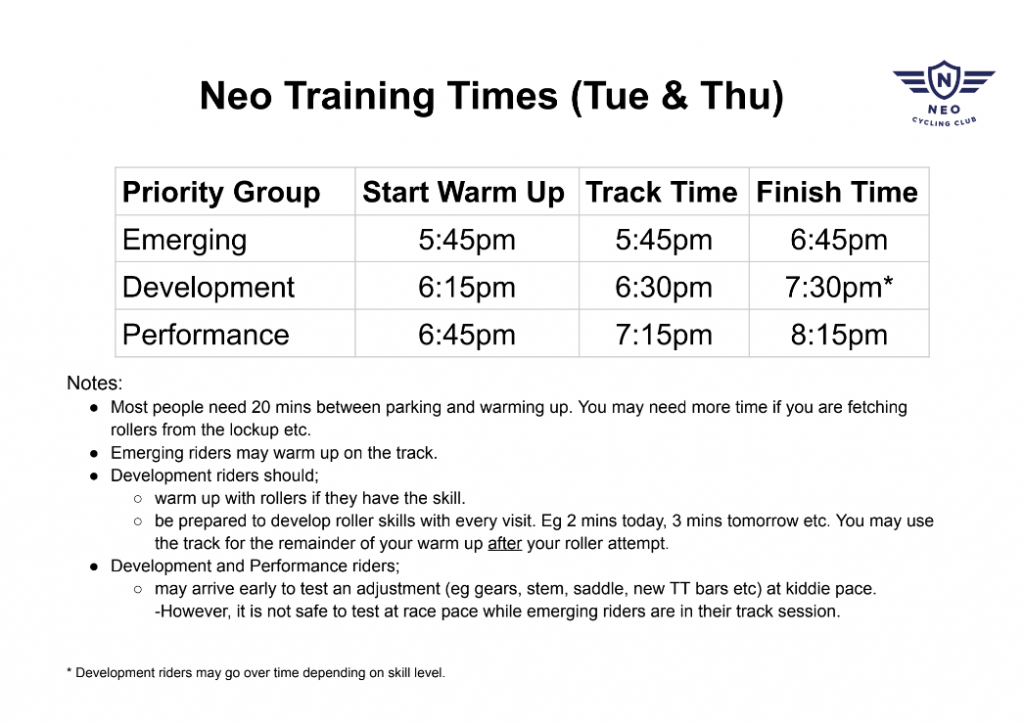
What type of bike?
We train on road bikes during road racing season (April to September) and track bikes during track racing season (October to March).
However, any members that aren’t on track bikes yet, may use their road bike year round.
For safety reasons we don’t mix road bikes and track bikes on the velodrome at the same time.
Track bike vs Road bikes
Track
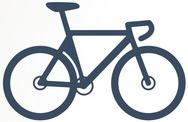
Track bikes are a velodrome specific bike ridden specifically on velodromes. They may only be legally used at a velodrome. -They look similar to road bike but with most of the componentry missing.
As the average person does not own a track bike, the club maintains a large fleet of them for you to try or even borrow long term.
Road
We train on road bikes during road racing season (April to September) and track bikes during track racing season (October to March).
However, any members that aren’t on track bikes yet, may use their road bike year round.
For safety reasons we don’t mix road bikes and track bikes on the velodrome at the same time.
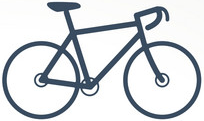
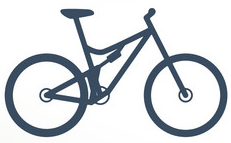
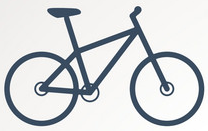
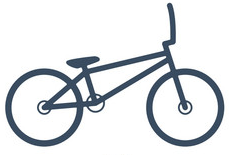
Road (Adult)
Technically, only the first bike shown here is a road bike. This is the bike that adults should think of when we talk about adult racing and training.
Road (Junior)
As for the Neo juniors, when we say “road bike” at training and at our weekly events, we are referring to any bike that has a brake, including those with levers and/or back pedal brakes. Such bikes include a mountain bike, comfort/flat bar bike, BMX bike etc.
It is normal for kids to be riding any of these particularly when they are starting out.
Road Rides
Saturday social rides
We run a free Saturday morning social road ride on most weekends. This ride targets, our older juniors and adults.
Check our calendar for contact details if you have any questions.
These rides aim to develop road riding experience, in a reasonably controlled environment, and provide the chance for some longer kilometres in the legs for the older juniors and adults alike.
For the younger juniors, rides are reliant on experienced adults and parents chaperoning the juniors, to help make these rides as safe as possible.
Location
All groups meet at Lilies on the Park (Café), Bicentennial Park, ready to roll at 6.55am (sharp). Back by 9.00am.
Non-riding parents are asked to remain at Lilies Cafe, or go for a walk nearby, so they can lend a hand or come and pick up any riders who are in need.
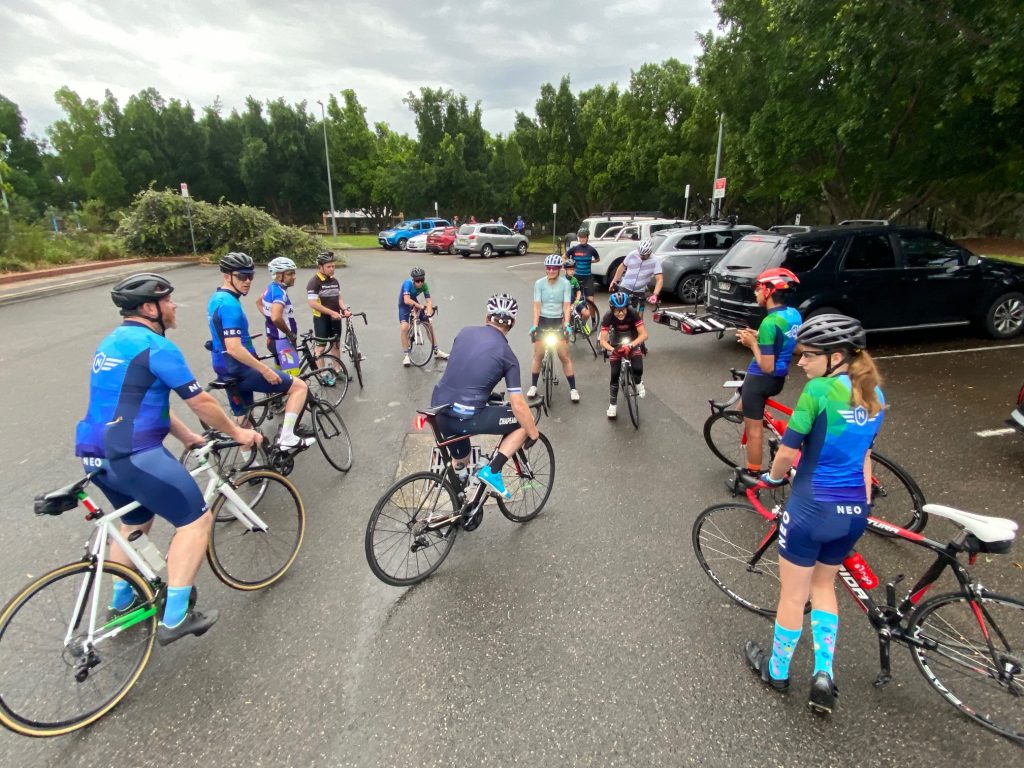
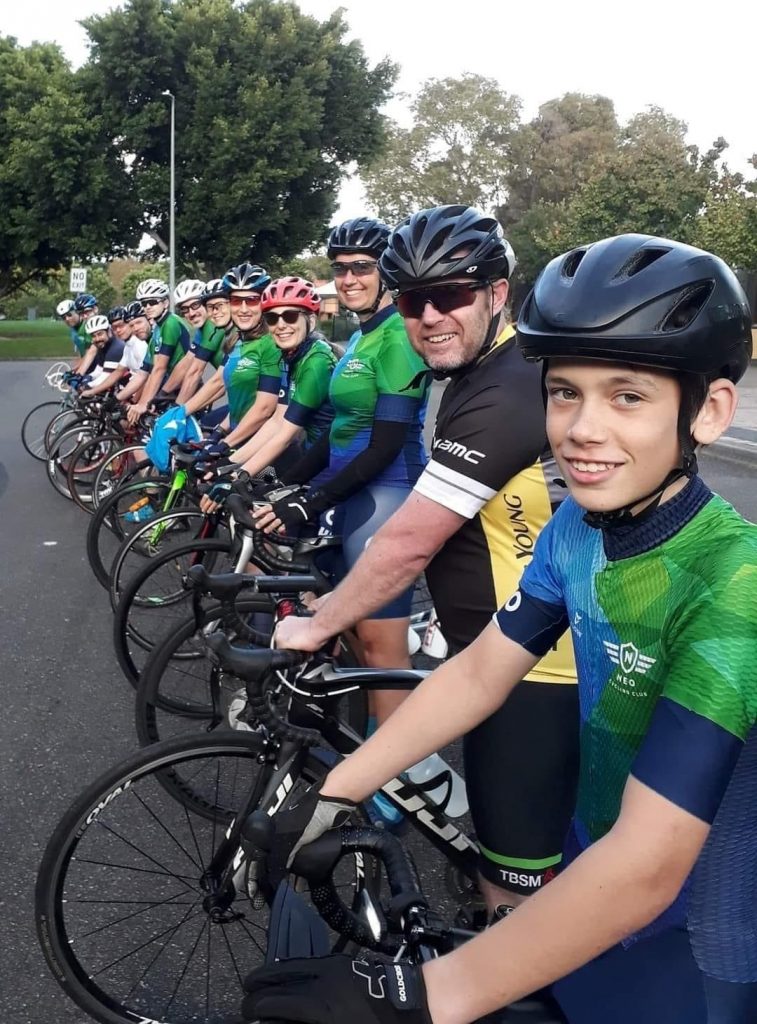
Groups
We run three groups, based on speed and road riding experience.
Slowies
30-40kms out to Parramata Park and back. Much of this ride is on bike paths, with some road riding required.
Middies
43kms involving some rolling hills on the road through Ermington and laps of Sydney Olympic Park.
Fasties
60-90kms, with more challenging destinations, Eg Bobbin Head or Brooklyn.
Riders in the fast group need to be self-sufficient with their own spares, lights and enough nutrition to cover a few hours of riding. They also need to have the skills to ride unsupervised.
Bike lights required
Lights, front and back, ARE A MUST for these rides.
Day-time lights are proven to improve visbility with drivers and pedestrians.
We recommend you invest and buy good quality lights that are USB rechargeable.
Want to join?
If you would like to join, or to lend a hand as an adult, and/or ride with your kid(s), please speak to our Ride Leaders.
To ride with us, you will need to be a current Season Ride member or a Season Ride + Prepaid Entries member. You will also need your own 24/7 insurance via an AusCycling ‘Lifestyle’ or ‘Race All Disciplines’ membership or Bicycle NSW (BNSW) membership.
Communications
If you’re coming to Saturday rides join our ‘Saturday Rides’ Facebook Messenger group to get the latest updates on training, weather cancelations etc.
Safety first – bunch etiquette
When riding in a bunch, there’s a lot to think about, to ensure your safety and that of others around you.
We want everyone to get home safely, so please take the time to read our practical guide to the safety considerations and etiquette of bunch riding, below.
GENERAL GUIDELINES
- Everyone wants to get home from the ride in one piece, we are all here for fun. If this doesn’t suit you, perhaps find another group.
- Ensure you have a safe and functioning bike. A well maintained bike is a safe bike.
- Obey the rules of the road. Always.
- Rides leave at the nominated start time.
- Ride in a predictable and constant manner. Remember your actions impact everyone in the group.
- Ensure you have a functioning front and rear light for riding, at all times. When riding in the peloton, please change your light setting to ‘constant’ to assist riders riding behind you. No one wants to be blinded by a flashing light.
- Be self sufficient. Have a spare tube, water, food and correct clothing for the day.
- Point out obstacles.
- Hold your line, especially around corners.
- Repeat calls and hand signals. It is often best to relay all signals by hand. There isn’t a need for 10 people to all be yelling “pothole” if they are all riding in a tight formation and it is a small bit of community awareness and etiquette to not wake the neighbourhood because we are on a ride and changing lanes. The exception to this rule is when travelling at high speed where it is best to keep both hands on the handlebars and use your voice instead.
- Leave the right distance to the riders in front. Roughly more than 50cm but less than a 1m between wheels. This is to leave some space for reaction times, but also not to have gaps bigger than 1m which will reduce the drafting benefit and cause the group to splinter. NEVER, EVER, OVERLAP WHEELS with the rider in front. If they change direction, that can cause a crash.
- Remember that YOU ARE RESPONSIBLE FOR YOUR FRONT WHEEL. As such, where you place it is your responsibility.
- Look forward at all times. You should not focus on the rear of the wheel of the rider in front but rather the person and the riders in front of them. By focussing on the person and the riders in front of them you will be more aware of what is happening in the bunch and give yourself more reaction time should there be an issue.
- Always be ready to brake, so in a peloton the best place for your hands is on your hoods. This means NO AERO BARS in any of our group rides.
- When riding in pairs, ride inline with the person next to you. Handlebar to handlebar. Do not “half wheel” – this means always riding just in front of the person next to you.
- Do your best to keep the group together. Call to “EASE UP” if you notice the group splitting or you’re struggling to maintain the pace (on group rides where this applies).
- Minimise braking, and always call out to the group when doing so.
- Skilled riders should be aware of less experienced riders in the bunch. For example do not bunny hop an obstacle. You may avoid a problem but you may lead others into one.
- Stopping too abruptly is dangerous and may cause an accident behind.
- Do not ‘filter’ to the front of a line of stationary traffic. Keep the group together and hold the lane.
- Approach all junctions where we do not have right of way by easing up and be ready to stop. This includes roundabouts and traffic lights that may change. The group may need to split if it’s a choice between this and a potential accident. Every rider must take responsibility. Just because the riders in front of you have rolled through, it does not necessarily mean it is safe for you to do so.
- On an incline beware of the ‘rollback’ from the rider in front if they get out of the saddle. If you are getting out of the saddle on an incline do not stop pedalling during this action since you will fall back into the rider behind who generally has to break hard or undertake a sudden swerve. Prior to getting out of the saddle make sure you are at the top of your pedal stroke and keep the pressure on the pedal.
- Help less experienced riders to learn group riding techniques and calls. We all were that new rider once.
LEAD RIDERS
- Ride at a constant speed. Only ever slow down if it’s clearly signalled to the group behind first. This means that riders on the front should always be pedalling unless avoiding an obstacle or coming to a stop.
- Remember at all times that there is a long line of riders behind you riding in close proximity at high speed with little time to react. Keep all actions smooth and predictable.
- When approaching a set of lights the lead riders have sole responsibility in making the call. It will either be “LIGHTS”, “STOPPING” or “ROLLING”.
- Make safe judgements for the whole group on whether or not to stop at junctions, roundabouts and traffic lights. Remember that stopping abruptly will cause an accident or near-miss further back in the group.
- We do not ride through red lights. When approaching a light that changes to amber the riders at the front will stop only if it’s safe to – call is “STOPPING”. If it is not safe to stop in such a short time call “ROLLING” to let all know that we’ll roll through.
- If you aren’t comfortable, call “STOPPING”. Riders behind the rider who has made the call to stop, do not over rule this call.
- Ease off from a standing start at a steady pace, this allows the riders at the back to not be sprinting off from every set of lights.
- Make the group aware of the need to change lanes well in advance of any obstacle such as a parked car or lane ending. Don’t jump in and out of lanes unnecessarily. If you have just moved out into the middle lane because of an obstacle, don’t move back left if you have to move out again in a short distance.
- Maintain the appropriate pace for the group. Ease up the pace if requested from behind to keep the group together.
- Rotate off in good time to make sure the other rider can maintain the pace for the duration of their turn at the front.
BACK MARKERS
- Make judgements on whether or not is it safe to change lanes.
- Make the call to ‘ease up’ if they see gaps in the group forming which are not being called by others.
- Call ahead to warn the group of a vehicle behind.
- Call ahead (ALL ON) to let the front riders know the group is united.
FORMATION & ROTATION
Generally, the group formation is two abreast, but be aware of the conditions and be courteous to the vehicles we share the road with. In small groups and / or on narrow roads to let vehicles pass, there may be a need to go single file for a period. This is important to keep in mind particularly when going up a hill or at a slow pace. Otherwise we ride two abreast.

Ride formation – “ two abreast and then roll to the left”
- When required, either of the front two riders will indicate a ‘rotation’ to each other, this is generally in the form of asking the other rider are you ready to ‘roll off’. The front-left rider will ease very slightly, and the front-right rider will pull over to the left and take over front-left position. The rider that was second in line on the right pulls up to take over front-right position.
- The rider coming through does not increase the pace.
- Each rider’s turn at the front depends how comfortable they are in holding the pace. On our fast group rides, the turns are only 20-30 metres long. Normal group rides turns usually last 500m – 2km depending on terrain.
A VEHICLE BEHIND
- On our rides we often ride on single lane roads and vehicles may approach and they may look to overtake. When a vehicle approaches from the rear of the group, the riders at the back of the group will call “CAR BACK” to warn the group that a vehicle will try and pass shortly.
- This is a warning to ride cautiously and hold tight formation allowing room for the vehicle to pass. Riders generally those at the back are then to consider the size of the group and the terrain and whether it would be appropriate to move into a single file.
- If it considered safe and appropriate to do so the call to move into a single file, the call from the back is “SINGLE FILE”.
OBSTACLES
- It’s important that we all point out obstacles such potholes, branches, gravel, or anything that may cause an accident. This is usually indicated by a rider pointing straight down in the direction of the obstacle either side of their bike. If it’s not safe to point, obstacles make by warned vocally (HOLE MIDDLE, GLASS LEFT, etc)
SLOWING GROUP
- If the front riders need to slow down this will be called by either “STOPPING”, “SLOWING” (for traffic lights), or “LIGHTS” calls. Usually this is accompanied by a single open palmed hand signal.
SETTING OFF
- This will be indicated by the “ROLLING” call. The same call may be used when going through an amber light to indicate that the front riders will not stop. If you’re towards the front of the group, remember not to take off too quickly. If you’re at the back and believe the group to be rolling slowly until all ready to roll, remember to call “ALL ON” to signify the front riders can get up to normal pace.
CHANGING LANES
- If there is a need to change lanes, the front riders will each put up a hand and call “CALL”. It then becomes the back riders responsibility to determine if it’s safe to move over.
- If it is safe, the riders at the back first take the lane and then call “OVER” to all the riders in front – who in turn move over. If a car is passing the group, do not call “OVER” until the car has passed the entire group.
- If it is not safe, the riders at the back call “WAIT” until it is safe to move over.
MECHANICAL PROBLEM
- In the event of a mechanical problem or puncture, the rider should raise their hand (if safe to do so) and call “MECHANICAL”. The rider and group will pull over to the side of the road as soon as it is safe.
PASSING OTHER GROUPS
- When approaching a slower rider/group, the riders at the front should call out “RIDERS” and ring their bell to warn the other party of our presence and give the ‘Move Right’ signal to the riders behind. Give plenty of space to riders when passing, particularly if you are in a large group moving at speed. Make sure you are well past the rider before moving back over to the left.
SUMMARY
Have fun on your ride, but keep your ego in check and your brain switched on. Group rides aren’t races, we provide plenty of opportunities to pin on a number and race. If someone is behaving inappropriately, call it out. It doesn’t matter if they are faster than you, or on a better bike, their actions can impact us all. We all enjoy riding our bikes, so observe these guidelines and everyone’s enjoyment will increase.
Before coming along
Before your first ride with us, there are a few things you should consider.
Every Rider
Juniors and adults MUST have either a BNSW membership, or AusCycling ride/race licence for insurance reasons. Responsibility for this insurance is always yours.
Juniors
All juniors U13 and below are expected to ride with their parents in the slow or medium groups. -Talk to the ride leader about the right group for your child.
Parents who can’t keep up with their child:
- require two adults (other than the ride leader) to commit to looking out for your child. -One adult to drop back for a child in need, while the other adult looks after the other children.
- require approval from the ride leader before every ride.
- should be available as a support person from Lilies Cafe. -If any rider (not just your child) has mechanical issues that can’t be resolved, we may call on you to drive over and rescue them.
- should exchange mobile numbers with the ride leader.
Juniors U15 and above may attend the fast group as long as they can ride without adult supervision. Riders spread out on the bigger rides and can’t all be watched at the same time.
Please note: Not all U15/U17 riders possess the skills to ride unsupervised. Both the parent and the ride leader need to feel comfortable about your child riding in this group.
Your child’s responsibility is always yours.
Adults
We’re an inclusive bunch and welcome new adult riders. Parents of juniors are also encouraged to join. We always need more adults to help keep young riders safe. -Talk to the ride leader about the right group for you.
Coffees
We finish the ride with a coffee, brekky and a chat back at Lilies on the Park. Always a great way to start your Saturday!
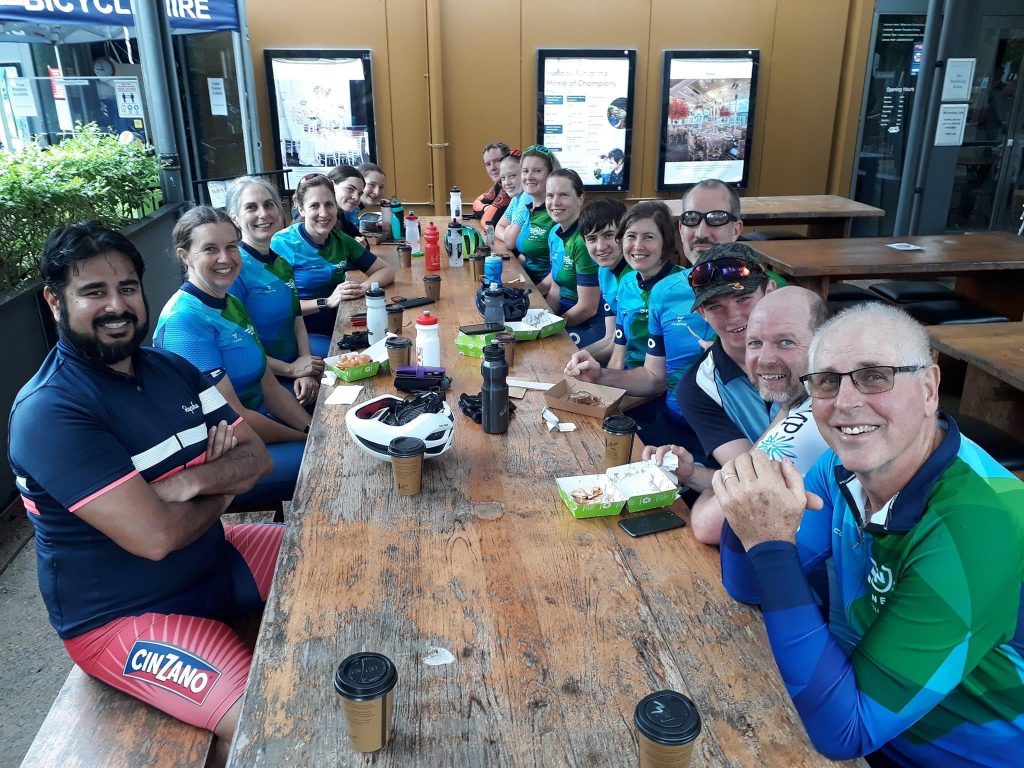
Virtual Training
Neo quickly adapted to Zwift training during the corona virus lockdown. Visit our Zwift page to learn more about our virtual training.
